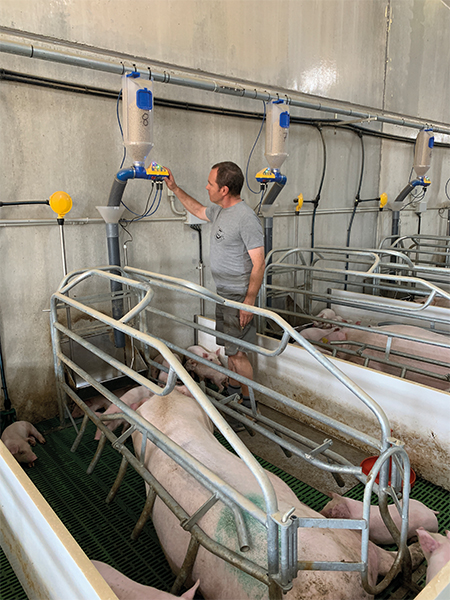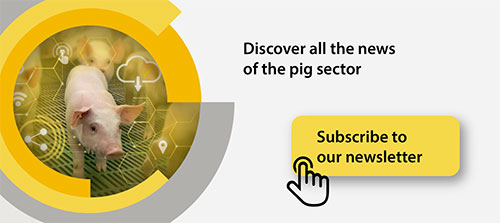Blog
Blog

How has the swine sector evolved in the last 30 years?
25th June 2024 - News
In the last thirty years, not only have we implemented essential changes in the productive structure of our farms, but also increased our production thanks to changes in genetics, the professionalisation of our sector, and the introduction of new technologies. As a result, we have achieved more well-being, healthier, and more efficient animals than 30 years ago. What has this evolution been like? We discussed this with Manolo Toledo, veterinarian and production manager at Grupo Frances.
What have been the main changes the pork industry has experienced in the last 30 years?
There has been a significant change, especially in the productive structure of the sector. I remember that when I started working, there were many more ranchers, but their farms were smaller. Now, there are fewer ranchers but with larger farms. As a result, there has been a significant improvement in facilities and animal management because we have people specialised in each of the phases. The other important change has been the genetics of the sows, which has changed. Before, sows were of one type, and their production was what it was. All these changes have meant that the efficiency of pigs is increasingly better.
Efficiency has been and is precisely one of the livestock farmers' objectives. How has progress been made in this regard?
Thanks to technology, we have made significant advances in efficiency. We have managed to adjust the structure of the farms and their design to the welfare needs of the animals, and we have reduced and adjusted feed consumption to meet the real needs of each animal by applying personalised feeding curves. Regarding this aspect, sows have gone from being animals to being similar to competitive athletes who must be given a diet designed to work perfectly. Finally, modernisation has made a rancher's job no longer as physical as it was years ago and has facilitated many day-to-day tasks on a farm.
On the other hand, production has grown to 102% in this period. Beyond the changes mentioned, what has contributed to this growth?
Genetics has contributed the most, of course, but it has also greatly influenced health improvement. Before, we had more diseases, and farm efficiency was much lower. For example, in maternity hospitals, having clostridium or diarrhoea leads to more problems. Luckily, there has been a significant advance in vaccines, which means we have many more healthy pigs.
As for farm productivity, how has it changed since then?
I remember that my first production premium was given to me by weaning 20 piglets, and that was around 25 or 30 years ago. The last one I got paid was from 28. With this, we can see a radical change in the productivity of the sows. The critical thing about productivity is how many pigs you take to the slaughterhouse. Those who die along the way don't count. I also remember that when we had PRRS outbreaks, we had mortality rates of 25% in fattening. So we needed to learn to tackle that or anything about everything known now.
Changes in animal welfare regulations have also led to significant advances. Which ones do you consider most beneficial?
All changes have been beneficial. The industry has improved faster and better than the regulations. We have reduced the number of pigs in the feedlots and the transition and made the animals do better. We have adapted very efficiently to the changes that the regulations entailed the sows in the group, and we have improved their well-being. We have reduced animals' stress levels by installing automatic feeding systems during lactation. We have installed systems to improve environmental conditions. All these changes have been significant and have brought benefits, but there have been other, more controversial ones, such as the limitations of the use of antibiotics. The knowledge of veterinarians in the field should be valued, and there should be awareness of what we use to medicate, why we should medicate, that we do it when the animals are sick and that we should not let them suffer. We agree that antibiotics must be reduced, but not that there is this persecution, and that we do not use common sense and apply rational use. Virtue is found in balance.

Electronic feeding system in farrowing with Dositronic. Photo: Rotecna.
What has the introduction of precision technology meant on pig farms?
The introduction of precision technology has brought about significant improvements in our industry. We've gone from having people manually feeding lactating animals to having an automatic feeding system that does that job for us very precisely. In this way, not only have we increased the weight of the piglets, which we have increased practically more than 500 grams, but we have also managed to have greater productivity in the sows in the next cycle because they give us more and higher quality piglets. We understand that these systems must be robust, simple, and practical for everything to work, and we acknowledge the challenges of implementing such technology.
At a health level, what has been the evolution?
Before, there were many things that we did not know, nor were aware of. For example, we called the first cases of PRRS the mysterious disease or blue ears. By calling it that, we have managed to sequence the virus. In all this time, we have progressed in managing animals to improve their health. We have developed vaccines, and all these tools have greatly enhanced it. I am convinced this will be the future soon, and we will use salivary biomarkers. We are now measuring oxytocin levels to know the stress levels in the sows. With this tool, we can monitor our animals, understand their functioning, and assess their acclimatisation.
A problem that has continued since then is the sustainability of livestock activity. What progress has been made in this regard?
Innovation has made us advance a lot. On the one hand, we have water consumption, something that we have managed to adjust and minimise water losses. We control consumption with a meter, have constant level buoys, and do not have pacifier breaks, which could cause water losses. Water, a scarce resource, is taken great care of. On the other hand, there is slurry. We have solid-liquid separators that reduce almost 30% nitrogen, but we also have many techniques to reduce nitrogen and put the right amount of nitrogen into the soil. We implement more methods every day, and the possibility of contaminating with nitrates is reduced more every day. We also control emissions with ECOGAN and will reduce them as technology and innovation give us tools.
Regarding markets, ASF in China has influenced pig activity in Spain. What does this mean beyond the export data that we already know?
In a way, it saved us. That brought the export strength of Spanish trade and slaughterhouses to the surface. China is still essential, but its exposure to the world market is incredible. The professionalism of exporters is formidable, and when one opening closes, they know where and how to open another and be able to place their products. That means that we can continue to produce because slaughterhouses can continue to sell. This makes the industry much more robust.
The Spanish pork sector's history has been a success story since the 1990s. Where are we going now?
There will likely be a need for pork production and consumption worldwide. High-quality meat like that produced in Spain will surely be necessary. Yes, indeed, we will only be able to grow a little due to environmental limitations, but it is also true that we will be much more efficient every day in producing quality meat.








